Some ten or fifteen years ago, complete adentia, or the absence of all teeth, was a real verdict and meant only one thing - the so-called "false jaw". The loss of one or more teeth was replenished in some cases with removable, and most often with non-removable prostheses, which rested on the remaining teeth. However, progress does not stand still, and today the most popular method of restoring lost and missing teeth is implantation. Mamedov Ilgam Vagifovich told us about all the advantages of implantation, chief physician and an orthopedist at the German Center for Aesthetic Dentistry SDent in Moscow.
What threatens the long absence of teeth?
The loss of one, and even more so several, not to mention all teeth, leads to a number of functional and aesthetic disorders. First of all, in the place of the lost tooth, a decrease in the jaw bone tissue begins, the so-called resorption. The teeth adjacent to the defect begin to move, trying to occupy the vacant space, which leads to a displacement of the dentition, a violation of the closure of the teeth, and also a curvature of their position.
With all this, the temporomandibular joint suffers, which is fraught with jaw clicks, headaches, constant voltage facial and lingual muscles, malocclusion and deterioration in the quality of chewing food. In the absence of front teeth, diction is seriously affected, saliva is sprayed when talking. With the loss of teeth in the lateral parts of the cheeks, they begin to sink, which not only makes the face look older, but also causes permanent microtraumas of the mucosa - simply “biting” the cheeks. By the way, negative changes in appearance, provoking, among other things, psychological problems, - a separate important aspect of the consequences of partial and complete adentia.
What are the hallmarks of proper dentures?
The main rule in the restoration of missing teeth is a harmonious and effective recreation of both aesthetics and functionality of the dentition. For 100%, only one can cope with this task. modern technique, namely - dental implantation. Today it the best way dental prosthetics.
What is meant by restoration of function and aesthetics? From an aesthetic point of view, a denture should not differ externally from natural teeth: it should have the same color and transparency of the enamel as the neighboring ones; to repeat anatomical shape tooth (this point also applies to functionality, as it ensures the correct closure of the dentition), soft gum tissues should fit snugly to it, the contour of which should be natural and neat (the so-called “pink” aesthetics of a smile).
As for the function, here we are talking about full participation in chewing and speech, as well as about the correct distribution of the load. When prosthetics based on neighboring teeth the entire load falls on them, which leads to their destruction and resorption of the bone under the prosthesis, the formation of "bedsores" on the oral mucosa and poor hygiene. When restoring teeth by implantation methods, an artificial tooth completely takes on all the functions of a natural one and does not differ in appearance from the neighboring natural teeth of the patient.
What are the pros and cons of dental implants?
Unlike traditional prostheses based on adjacent teeth, the implant does not interact with them in any way, contributing to correct distribution chewing load. One hundred percent efficiency in restoring the function and aesthetics of the tooth is the main and undeniable plus of implantation. In addition, the conditions of our clinic and the qualifications of doctors make it possible to reduce the treatment time using a sparing implantation technique (minimally invasive) without additional bone growth, by installing implants immediately after tooth extraction. At the same time, chewing efficiency and aesthetics are not lost, since temporary crowns are made for the patient during the engraftment of implants. Among the minuses, they usually name a higher price compared to traditional prosthetics, however, in terms of a long term, implantation is not only not expensive, but even a much more economical measure. The fact is that, unlike classical prostheses, a dental implant serves its owner throughout life.
How exactly is traditional prosthetics different from implantation?
Prosthetics differs from implantation in the way the prosthesis is installed, all other differences are a consequence of this. First, both removable and not removable prosthesis s(with the exception of the false jaw, which we will talk about separately) are installed with support on adjacent teeth. To do this, in most cases, these supporting, initially healthy, teeth are depulped, that is, they lose the nerve. A tooth without a nerve is dead tooth, it is easy to guess that soon it will begin to collapse, and in a few years it will take new prosthesis replacing, among other things, the once perfectly healthy abutment teeth. Thus, the answer to the question: "Which is better - prosthetics or implantation?" becomes more and more obvious.
Secondly, between the gum and a removable, as well as fixed, prosthesis, in most cases there is a certain gap in which plaque, bacteria and food debris accumulate, which negatively affects the gum under the prosthesis.
Thirdly, as already mentioned, the load during chewing in the case of traditional prosthetics is unevenly distributed, which leads to accelerated destruction of the supporting teeth and irreversible changes in the structure of the jawbone, in other words, to its loss. By the way, the only way to restore a resorbed bone is through surgery.
As for a complete removable denture, here the loss of bone tissue becomes catastrophic, and reliance on the gum mucosa (due to the absence of supporting teeth) leads to constant rubbing and chronic diseases oral cavity. And if bridges and clasp prostheses simply cause inconvenience, both aesthetic and functional, then the so-called dentures- this is a real disaster: it constantly moves inside the oral cavity, falls out, rubs, interferes with speaking, does not allow you to fully chew food.
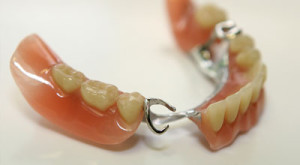
Is implantation always possible and are there indications for traditional prosthetics?
A few years ago there were strict contraindications to implantation, however, with the improvement of techniques and the development of medicine, these contraindications have practically disappeared. As regards such systemic diseases, like diabetes, coagulation disorders (blood clotting) and some others used to mean one thing: only traditional prosthetics, no implantation. Taking into account how dental implantation is done today, implantation of dental implants is also possible in these cases, the only difference is that the doctor performing the operation must have the knowledge and skills appropriate to the situation, and the patient must undergo thorough preparation for dental implantation and strictly observe doctor's recommendations and listen to your own body during the rehabilitation period.
We compare service life: what is more durable - prosthetics or implantation?
As mentioned above, a titanium root implanted in the jaw during implantation serves its owner throughout life, thanks to the phenomenon of osseointegration - the ability of bone tissue to fuse with the implant body. A crown placed on an implant lasts from 10 to 15 years, depending on whether it is a posterior or anterior tooth. As for bridges or clasp prostheses, they require complete replacement on average every 5-7 years, and the abutment teeth under them, prone to destruction, increase the length of the required prosthesis over time. Removable dentures require regular relining and periodic complete replacement.
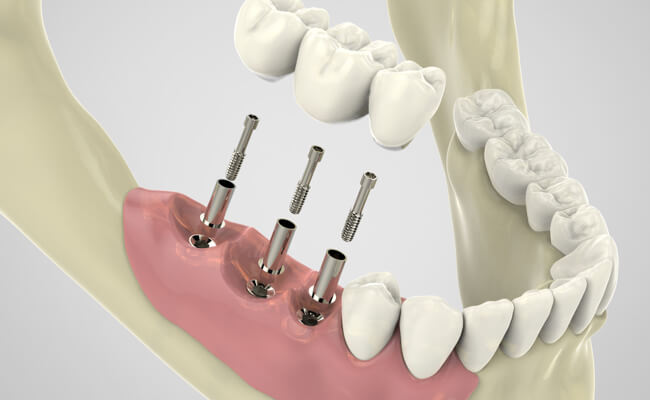
Dental prosthetics and implantation - which prices are higher?
As mentioned above, in terms of the long term, implantation is no more expensive, and even more economical than installing a traditional prosthesis. This is due to the fact that the implant is paid for by the patient only once, and the crowns on it need to be replaced very rarely, while the usual removable or fixed dentures, each of which is cheaper than the implant itself, must be completely renewed much more often, which ultimately rises to more than a round sum.
Reflecting on what is better - prosthetics or implantation, let's compare the prices for implantation and conventional prosthetics. Reliable implant together with ceramic or ceramic-metal crown, indistinguishable from a natural tooth, will cost an average of 50,000 rubles and will last the rest of your life. A bridge that replaces just one missing tooth costs about 30,000 rubles. Further - simple mathematics: the next installation of the bridge, which will be required in 5-7 years and will restore not one, but most likely two or as many as three teeth, will reduce all the "savings" to nothing.
Which is better - prosthetics or dental implants?
Before you finally decide on the choice in favor of prosthetics or implantation, we would like to draw your attention to one important point, which is of paramount importance in any treatment. This is the presence of specific indications and contraindications for prosthetics or implantation in your case. And to form a clear idea of the advantages and disadvantages of these procedures, we suggest that you familiarize yourself with the table below.
| Type of treatment | Advantages | Flaws |
| Prosthetics |
|
|
Implantation |
|
|
Summing up, we can say that the most effective method restoration of lost teeth is implantation. Traditional prosthetics are slowly but surely becoming a thing of the past. Conscientious specialists prefer not to contact him even in case of complete edentulousness: modern solution This problem is the installation of a full denture on 2, 4 or 6 implants or mini-implants. However, implantation has its pros and cons, which the doctor must take into account when choosing one or another treatment method.
Prosthetics is the restoration of lost molars in adults and children with the help of artificial prostheses. This process solves several problems:
- resumption of chewing function;
- prevention of the development of any complications and serious diseases;
- improving the quality of life;
- elimination negative consequences for the psyche due to the lack of anterior crowns.
When is dentures needed?
Prosthetics are indicated if certain prerequisites are present. Using a simple example (loss of one or more teeth), it will become clear why this is so:
The main indications for the insertion of artificial teeth:
- Significant destruction of the crown (resuscitation by filling is impossible). As a rule, in this case, it is worth replacing one missing organ with inlays or artificial crowns.
- The crown was removed entirely. Pin insertion shown.
- Erasure of upper and lower teeth v pathological form. Prosthetics with veneers or crowns.
- Adentia (there are no teeth themselves and their roots). The method of prosthetics directly depends on the characteristics of the defect.
- Numerous pathologies of the dentition. With age, there are many problems that are an indication for the insertion of prostheses. All methods of restoration of molars and prostheses of any design are used - the decision to put a gold, ceramic or other tooth is made by the patient together with an orthopedic dentist.
Options for replacing natural teeth - before and after photos

The choice of type of prosthetics is directly dependent on specific situation and material wealth of the patient (they do both gold and ceramic teeth). You can and should make a decision together with the dentist. To rely on positive reviews relatives and friends, if they were satisfied with one or another type of false prosthesis, there is no need, because each organism is individual.
Which tooth to insert is decided by the patient, taking into account the opinion of the attending physician. The best solution- rely on the patient's state of health, his lifestyle before the procedure and financial capabilities, instead of the opinions of strangers.
Removable or not?
Fixed dentures are more expensive than removable ones, which is explained by their strength and good biological compatibility of manufacturing materials with dental and gum tissues (the article presents photos before and after fixed prosthetics). Installation technology will depend on each specific case. The types of such prosthetics include the following:
- inlays and veneers (reanimate damaged teeth and restore their former appearance);
- crowns (imitate the natural shape extracted tooth);
- bridges (a combination of several crowns in one design);
- implants (artificial roots intended for the subsequent installation of artificial crowns on them).
Mounting methods
Dental prostheses are attached using their own elements or using additional funds commits:
- Clasps (hooks). The type of attachment that is cheap. Applicable for removable prosthetics, is made from materials for the manufacture of the base of the prosthesis (metal, acrylic, polyurethane, nylon, etc.). Clasps are located at the base of the abutment teeth.
- Attachments (also called locks). They are used for removable and non-removable bridge prosthetics. They have an important advantage over clasps: they can be overlooked by others, since they are fixed in the recess of the supporting teeth and are closed from above with crowns.
- Flexible base. Expensive way of prosthetics. Production material: nylon or polyurethane (cheaper domestic analogue). They are attached with a flexible base made of natural substances that adhere securely to the mucous membrane. oral cavity without the use of additional funds.
- Dental glue ("cement"). Crowns, veneers and inlays are fixed on it.
- Additional means of fixation. These are gels and creams, presented in a wide range in all pharmacies. Allow to fix removable or conditionally removable prostheses.
Microprosthetics of the anterior teeth
Microprosthetics is a modern dental procedure. Its goal is to preserve the dentition with significant destruction, improve the aesthetic component of the teeth and restore the chewing function. There are the following types:
- Adhesive. Allows replacement of one or more missing front teeth. In most cases, high-strength fiberglass is used, so structures of this type can generally serve long years. This method necessary for those people who are at risk of allergies to metal (with the exception of gold teeth) prostheses or their bases. The cost of a fiberglass prosthesis is lower than with other materials.
- Installation of veneers (overlays). Veneers are thin plates that are attached to the outer part of the tooth and significantly improve its appearance (shape, color). They hide chips and areas of blackening on the enamel. Also, the pads allow you to hide the gaps between the front teeth and protect the enamel from exposure. external factors(coffee plaque, tobacco smoke, mechanical damage).
- Tab prosthetics. This is the use of special laboratory-made fillings, which have not only increased strength, but also a beautiful appearance.
- The use of pins. Apply in the case when the crown is destroyed, but the root is healthy. The pin is placed in the root of the tooth, and an artificial crown is placed on top. You can insert a tooth without turning the adjacent chewing organs.
Material selection
Even in ancient times, people tried to find a replacement for lost teeth, using wood, stones, pearls, gold and other items. V modern dentistry everything is different - prostheses are durable and safe for the patient's health. The most common manufacturing materials:
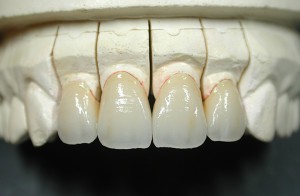
In each specific situation, materials are selected individually. It all depends on the indications for prosthetics, its method, the wishes of the patient and financial capabilities.
plastic
Plastic dentures are made from acrylic. Used for full or partial absence teeth. Varieties:
- Lithium and pressed. The first are attached to the jaw with high precision, almost indistinguishable from "living" teeth. The second ones are easier to manufacture, but inferior to lithium ones in quality.
- Removable (used most often) and non-removable.
- Permanent and temporary.
Ceramic
Ceramics is a material intended for the manufacture of durable and aesthetically attractive dental crowns. There are several options for the execution of ceramic prostheses:
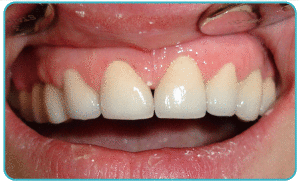
Advantages and disadvantages of different types of prostheses
Advantages of plastic dentures:
- can be used as temporary;
- have a low cost;
- there is a resemblance to natural teeth.
Flaws:
- wear out quickly;
- irritate the oral mucosa;
- sometimes cause allergies;
- some time after installation, food debris may accumulate under the crown;
- cause discomfort.
Advantages of ceramic prostheses:
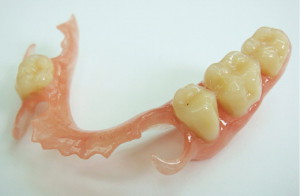
Flaws:
- there is a possibility of chips after prolonged use;
- high price.
Overview of the cost of dentures - which are the most expensive?
When it becomes necessary to insert a denture, the patient is always interested in how much money he will have to pay for it. Most often, the choice of one or another method of prosthetics depends on financial capabilities. The price is affected by:
- material of manufacture (gold teeth will be better, but they are more expensive than acrylic ones);
- design features (clasp, lamellar, bridge-like, etc.);
- the complexity of the installation (the number of lost teeth, the need for preliminary treatment and restoration).
The cheapest dentures are made of acrylic, which cannot be said about other materials. Clasp and nylon are about 3 times more expensive. The price of bridges will depend on the design and material of the crowns.
Gold artificial teeth have been inserted since ancient times. More recently, at the end of the 20th century, gold crowns were very popular and were a sign of the wealth of their owner. V last years patients are increasingly asking for gold dentures with a special coating that mimics natural tissue. Gold alloy teeth do not cause allergic reactions.
Article navigation
Absence of two or more standing teeth- one of the most common cases in dentistry. Restoring the aesthetics and functionality of the dentition involves several solutions: you can use a removable denture or install a dental bridge based on two or more adjacent living teeth. However, most dentists agree that the most in an efficient way is dental implantation.
Classic options for prosthetics: why not?
In the absence of two or more teeth nearby, the most common method of closing a gap in a row is considered to be the installation of a dental bridge - this is an alternative to dental implantation. In place of the missing teeth, there will be "suspended" (middle of the bridge), and along the edges of the bridge there will be crowns resting on the abutment teeth. The more missing teeth, the more abutment teeth are used.
The abutment teeth are subject to depulping and turning for the installation of a bridge, and this is one of the main disadvantages of dental bridges.
If the living teeth are in bad condition and will not withstand the load from the prosthesis, the patient has one more option - to close the gap between the teeth with removable dentures.
It should also be remembered that in both cases, under the prostheses, the process of bone atrophy actively continues, which occurs when there is no load on it. Gradually, a small gap appears between the prosthesis and the edge of the gum due to a decrease in bone volume.
Multi-tooth implant options
In the absence of two teeth, an individual implant is installed under each of them, and a dental bridge from the selected material is fixed on top. If more than three teeth are missing in a row, then the number of implants is selected individually, you can install 2 implants and a dental bridge of 3 crowns. However, at the request of the patient, it is also possible to restore each tooth separately with the help of an implant and a single crown. Most often, for the restoration of several teeth in the frontal zone, patients are recommended dental implantation according to the classical protocol, which allows to obtain a predictable result and good aesthetics of the gingival contour. The only drawback of this approach is its delayed loading, a permanent prosthesis can be placed only after the implants are completely engrafted, while a temporary prosthesis-butterfly will have to be worn for the duration of the fusion of the implants with the bone.
For those who do not want to wait, this process can be shortened by immediate loading implantation, which allows the patient to receive new teeth in the shortest possible time (usually no more than 5 days). However, immediate loading implantation has an important limitation, its goal is primarily to restore the functionality of the dentition and for some clinical cases the aesthetic aspect will be unsatisfactory. To understand whether this method is suitable, you need an examination by an implantologist.
Advantages of implantation in multiple restorations
- preservation of neighboring teeth: there is no need for preparation (turning) and depulpation of neighboring living teeth, on which a bridge is put on;
- high aesthetics: artificial teeth based on implants are almost impossible to distinguish from natural ones;
- preservation of bone tissue: chewing load is transferred to the bone through the implant, so it “works” in the usual mode and does not decrease in size,
- reliability and durability of implants: implants are made of the strongest titanium, which allows them to withstand high chewing loads and serve for 20-30 years. For prosthetics on implants, it is also better to choose strong, durable structures, such as metal ceramics or zirconium dioxide. If over time it becomes necessary to replace the prosthesis, it is carefully removed and replaced with a new one, while the implants remain in the bone tissue.
Thus, dental implantation is the most effective and aesthetic way to restore two or more lost, previously adjacent teeth.
The cost of implantation of several teeth:
When restoring several teeth in a row, the cost of dental implantation may vary depending on whether each tooth will be restored with a separate implant and crown, or a dental bridge will be installed. For example, in the absence of three teeth, you can install three implants and three crowns, or a bridge of three crowns supported by two implants, thus saving on quantity. The second important factor affecting the cost of dental implantation is the type of dental crowns, since the difference in price between different materials can be significant. However, when choosing the method of implantation and the type of crowns, one should not be guided solely by considerations of economy, since the quality of the materials primarily affects the service life of new artificial teeth.
You can find out more about the cost of all manipulations at free consultation implantologist, since only after examining the oral cavity and diagnosing it will be possible to draw up specific plans treatment, pick best options restoration of teeth for each individual case. However, do not forget that in clinics hotline special promotions for dental implantation are regularly held, which will allow you to get quality treatment at a favorable price.
When teeth are missing on only one side of the jaw, this is officially called: a unilateral end defect of the dentition.
There are a lot of options for prosthetics in this case. The reason for diversity is that there is no single one that would suit everyone and everything. Let's figure out how such a defect can be filled. Four options are possible:
1. Dental implants
A good option - neighboring teeth are not involved in any way. And you won’t have to remove anything - the crowns will be non-removable. Minus one - if there is not enough bone, it will have to be added. Which will add cost and time.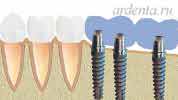
2. Cantilever bridge
The fastest, most convenient and economical option for prosthetics of unilateral end defects - you quickly get used to it, it is simple - you do not need to remove anything and mess with implants. Perfect if not chewing teeth I really don't want to get implants.At least two extreme teeth will have to be processed. If they themselves require prosthetics with crowns, this option for restoring the end defect is optimal. If they are completely healthy, dental implantation will be more rational.
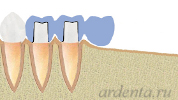
The disadvantage of a bridge is that it can only restore one missing tooth. If you add two teeth, then the abutment teeth will not last long due to the heavy load.
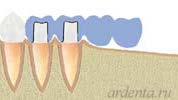
Some patients insist on adding two teeth (although this is very wrong). Then their chewing surface becomes incomplete - so that the teeth look natural with outer side, but did not overload the reference ones.
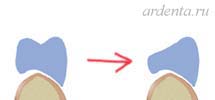
3. Traditional removable prosthesis
A conventional removable denture can restore a unilateral defect in the dentition. But due to the presence of teeth on the other side, patients do not use them. Will try for a week or two. And put them literally on the shelf:The main reason for the inconvenience is the large volume of the prosthesis. The improvement in chewing food will turn out to be small, but the inconvenience ... much more.
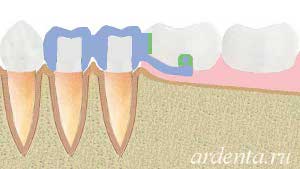
Prevention of end defects
If there is still at least one extreme tooth on the side with missing teeth, then it is necessary to save it if possible. Even if it's badly damaged. In order not to lead to the appearance of an end defect in the dentition. Which is not very easy to prosthetize without implants.If the last tooth is badly damaged, it is possible to restore it in most cases. Don't grab the forceps right away. Try to save it first. If the damage is strong, reinforce it with a pin.
If there is inflammation on the roots of a tooth that has not yet been removed, then treat them and save them. And use in the future for prosthetics.
The loss of attractiveness and integrity of a smile affects almost every person sooner or later. Regardless of age, it is necessary to make a decision about the choice of dental prosthetics in the absence of a large number teeth.
What methods can be used to solve the aesthetic problem, as well as restore the functionality of the jaw, we will describe in detail with a description of the pros and cons of each of them.
Methods of prosthetics of teeth with a large absence of them
Prosthetics is the only way to restore the integrity of the row, restore chewing functions and the naturalness of a smile. Depending on the number of lost units and their location, a more suitable variant of the prosthesis will be selected. Currently available designs:
- Removable, which include all plate types and.
- Fixed - crowns, bridges, implants.
Decision on best choice should be jointly taken by the doctor and the patient, since the first can point out the advantages and disadvantages of each of them, and the second is guided by the amount that he can afford to spend on the procedure.
If the number of lost teeth is single, then crowns are most often chosen. And with extensive loss, more reliable and durable structures are needed.
Bridges
The most popular fixed prosthetic option is the bridge. It is used if it is necessary to restore from one to four units in a row. In other circumstances, a different design option is required. The more teeth that are restored with the help of a bridge, the less durable the prosthesis will be, and the time of its operation will be much shorter.
For example, if 2 teeth are lost in a row, then the bridge will be an ideal solution both in terms of price and ease of use. Using ceramics or cermets, you can be sure that the prosthesis will last more than five years. But plastic is used only on the front teeth, because the chewing load on the lateral part is too large for them, which will lead to the rapid destruction of the material.
The technique of such prosthetics is quite simple. The outer teeth are ground and crowns are placed on them. And a bridge is attached to them with necessary quantity artificial units. This type of prosthetics has been very popular for many decades and is a fairly convenient and cost-effective solution for most cases of missing teeth.
The disadvantages of bridge structures are damage to soft tissues over time, and the ingress of food debris under the structure itself. And also it cannot be established if there are no more than four units in a row in the row.
Removable dentures
Prosthetics in the absence of a large number of teeth involves more voluminous and reliable designs.
These include clasp prostheses and lamellar ones made of various materials. Each of them has its pros and cons, features and, of course, they differ significantly in price.
Nylon
When more than 3 teeth have fallen out in a row, it is better to make a removable plate on which artificial teeth will be fixed. Nylon is considered the most convenient of the plate options, and all thanks to the following advantages:
- Hypoallergenic material suits a large number of patients.
- The soft and flexible plate feels better in the mouth and is easier to adapt to.
- With constant operation, there is a gentle effect on the supporting units.
- Nylon does not absorb excess odors, does not change color due to the denser structure of the material, compared to acrylic.
- Aesthetic component - they are as similar as possible to natural gums and teeth.
True, there are a few downsides:
- Due to the softness of the material, it is erased and worn out over time.
- Possible damage to the mucosa, which decreases every year by 1 mm from the constant pressure of the prosthesis.
- Such material is almost impossible to perfectly polish, which can give the teeth an untidy appearance.
- Relatively short term prosthesis service - up to three years.
- High price compared to the same acrylic counterparts.
- The design may lose its shape over time, it needs to be corrected and corrected periodically.
Nevertheless, this option is quite popular among patients and is often preferred.
Acrylic
Such prostheses are made of an acrylic base, on which artificial units are attached. The following advantages of the material are distinguished:
- The cheapest of all options.
- Lightweight, so there is a sparing effect on the abutment teeth.
- Due to the hardness of the material, unnecessary stress on the gums is prevented, which keeps them for longer. a long period.
- Fast production than no other prosthesis can boast.
There are also many cons:
- The possibility of injury to soft tissues due to rubbing in adjacent areas.
- There are cases of allergic reactions to acrylic material.
- Increased porosity causes unpleasant odors and sometimes changes in the color of the base.
- If such a plate is fixed on the last remaining teeth, then they begin to experience increased load.
- There is a displacement of the prosthesis, due to which there is a violation of diction.
- The bone tissue underneath will atrophy over time.
Clasp prosthetics
Clasp structures have become more modern analogue plate prostheses. They can be either removable or non-removable, have different kinds mounts, and are also able to replace lost units in any quantity. Important nuance- at least some natural teeth should remain in the mouth so that it is possible to fix the structure on them.
Obvious benefits bugels made them popular among patients:
- Due to the absence of a plate, which is replaced by a thin support, the comfort of use is increased. Above and below, the palate remains free, and the tongue has enough room for movement.
- Convenient fasteners make them invisible in most cases.
- Availability to use this method of prosthetics even in the presence of bruxism and periodontal disease.
- Longer service life due to structural strength. Approximately seven years warranty is expected.
With all their advantages, clasp prostheses are characterized by high cost. Also, they cannot be used total absence jaw teeth.
Video: or removable dentures?
Implantation
The installation of implants is considered the best and most reliable solution in modern prosthetics. They can be used both in case of loss of one unit, and a whole series. Even in the absence of chewing teeth, the strength and durability of the structure can be guaranteed.
The main essence of the method is that a rod is implanted into the soft tissue, which is called a gum shaper. After it calms down and heals, with the help of an abutment, an artificial crown is attached from any chosen material. This procedure takes a long time and is equivalent to surgery, but the reliability of the result exceeds all expectations.
If implants are used with the loss of most of the dentition, then they will not necessarily be placed in the same number as the lost units. Three or four is enough to securely fix the prosthesis.
An extensive number of advantages made this type of prosthetics the most popular:
- The remaining units do not deteriorate or grind.
- Strong fixation gives confidence that the implant will not fall out or even break.
- The ability to restore any lost row - from one unit to the whole jaw.
- no load and negative impact on the bone tissue.
- Full preservation of diction, convenience of chewing function and taste sensations.
- The aesthetic value of the design - each tooth corresponds to the natural appearance, imitating it as much as possible.
- soft tissues are open and there is no undue pressure on them.
- Durability of operation. Doctors give a guarantee for 25 years of active use.
- In case of breakage of the external parts of the structure, it is enough to replace only the damaged element, the rods remain intact.
Nevertheless, some disadvantages can scare off impressionable patients:
- The implant procedure is surgical intervention, and the tissues after that heal for a long time.
- Possible rejection of the material by the body.
- Soreness of the procedure and the period of gum formation.
- Occur often inflammatory processes during adaptation.
- There are a number of contraindications and unpleasant consequences.
- The most high price compared to all other prostheses.
In addition to choosing the type of construction, as well as the material from which it will be made, you can also decide on the material for the manufacture of artificial teeth. Indeed, a variety of crowns can be installed on almost all types of prostheses - from plastic to gold. What to choose depends entirely on the financial capabilities of the patient and the requirements for the final appearance of the restored dentition.





